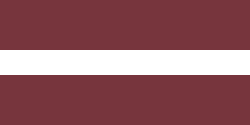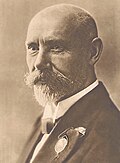Latvia
Latvia (Latvian: Latvija), officially the Republic of Latvia (Latvijas Republika), is a country in Northern Europe. The capital is Riga. It is one of the Baltic states, together with Estonia in the north and Lithuania in the south. Latvia's neighbours to the east are the countries Russia and Belarus. Latvia is divided into four parts: Kurzeme, Vidzeme, Zemgale, and Latgale.
Republic of Latvia Latvijas Republika | |
|---|---|
| Anthem: | |
![Location of Latvia (dark green) – on the European continent (green & dark grey) – in the European Union (green) — [Legend]](https://upload.wikimedia.org/wikipedia/commons/thumb/3/32/EU-Latvia.svg/500px-EU-Latvia.svg.png) Location of Latvia (dark green) – on the European continent (green & dark grey) | |
| Capital and largest city | Riga 56°57′N 24°6′E / 56.950°N 24.100°E |
| Official languages | Latvian |
| Latvian, Russian, Belarusian, Lithuanian, Ukrainian, Polish, Romani | |
| Ethnic groups (2011) | 62.1% Latvians, 26.9% Russians, 3.4% Belarusians, 2.2% Ukrainians, 2.2% Poles, 1.2% Lithuanians, 2% others and unspecified[1] |
| Demonym(s) | Latvian |
| Government | Parliamentary republic |
| Edgars Rinkēvičs | |
| Evika Siliņa | |
| Daiga Mieriņa | |
| Independence | |
| 18 November 1918 | |
| 26 January 1921 | |
| 5 August 1940 | |
| 10 July 1941 | |
| 8 May 1945 | |
| 4 May 1990 | |
• Restored | 21 August 1991[2] |
| Area | |
• Total | 64,589 km2 (24,938 sq mi) (124th) |
• Water (%) | 1.57% (1,014 km2) |
| Population | |
• 2011 estimate | 2,229,641[3] (143rd) |
• 2000 census | 2,377,383 |
• Density | 34.3/km2 (88.8/sq mi) (166th) |
| GDP (PPP) | 2010 estimate |
• Total | $32.513 billion[4] |
• Per capita | $14,460[4] |
| GDP (nominal) | 2010 estimate |
• Total | $24.045 billion[4] |
• Per capita | $10,694[4] |
| Gini (2003) | 37.7 medium |
| HDI (2011) | very high · 43rd |
| Currency | Euro (€) (EUR) |
| Time zone | UTC+2 (EET) |
• Summer (DST) | UTC+3 (EEST) |
| Driving side | right |
| Calling code | +371 |
| ISO 3166 code | LV |
| Internet TLD | .lv |
1 Latvia is de jure continuous with its declaration 18 November 1918. | |
People from Latvia are called Latvians. They speak the Latvian language, which is a little like the Lithuanian language but is not close enough to be understood. There are other peoples that live in Latvia, including the Germans and the Russians.
History
Latvia was settled by the Baltic tribes thousands of years ago. They mainly fished, hunted, and traded.
German traders and crusaders came to Latvia at the end of the 12th century. Latvians lost control of their homeland. Over the next 800 years, Germans, Danes, Swedes, Poles, and Russians all invaded Latvia. Latvia finally became independent in 1918.
Between the 13th and the 15th centuries, the Teutonic Knights had a state that occupied Latvian territory.
Before World War I, the aristocracy was mainly German.
During the Great Northern War from 1700 to 1721, what is now Latvia became the part of the Russian Empire and were organized as Courland and Livonia.
Latvian workers took part in the revolutionary struggle in 1905.
In 1940, Latvia was annexed by the Soviet Union. It was briefly under German occupation during World War II in from 1941 to 1944.
After the war, many factories were opened. Latvia became one of the more successful Soviet republics.
In 1991 the Soviet Union collapsed, and Latvia had its independence restored.
Politics
In Copenhagen on 13 December 2002, Latvia and nine other countries were invited to join the European Union. On 20 September 2003, Latvians held an election to vote on joining. Two thirds of Latvians voted to join, and on 1 May 2004, Latvia became a member of the EU.
Latvia has been a NATO member since 29 March 2004.
There are 43 local government units, set up in 2020. 36 are municipalities (Latvian: novadi) and 7 state cities. Before 2020 there were 110 municipalities and nine republic cities.[6]
International rankings
Latvia Media
National Anthem of Latvia "Dievs, svētī Latviju!"
Turaida Castle near Sigulda, built in 1214 under Albert of Riga
The Swedish Empire (1560–1815).
Latvians national rally in Dundaga in 1905
Jānis Čakste (1859–1927), the first president of Latvia
Red Army soldiers in front of the Freedom Monument in Riga in 1944
Barricade in Riga to prevent the Soviet Army from reaching the Latvian Parliament in July 1991
Related pages
References
- ↑ "Etniskais sastāvs un mazākumtautību kultūras identitātes veicināšana". Latvijas Republikas Ārlietu Ministrija. Archived from the original on 12 July 2011. Retrieved 2 December 2011.
- ↑ "History – Embassy of Finland, Riga". Embassy of Finland, Riga. 2008-07-09. Retrieved 2010-09-02.
Latvia declared independence on 21 August 1991...The decision to restore diplomatic relations took effect on 29 August 1991
- ↑ "Total population". Centrālās statistikas pārvaldes datu bāzes. 2011. Archived from the original on 26 May 2012. Retrieved 5 November 2011.
- ↑ 4.0 4.1 4.2 4.3 "Latvia". International Monetary Fund. Retrieved 2011-04-30.
- ↑ "Human Development Index Report 2011". United Nations. 2011. Retrieved 2 November 2011.
- ↑ "Saeima finally approves major regional reforms". eng.lsm.lv. Retrieved 2023-09-10.
Other websites
| Wikimedia Commons has media related to Lua error in Module:Commons_link at line 62: attempt to index field 'wikibase' (a nil value).. |








